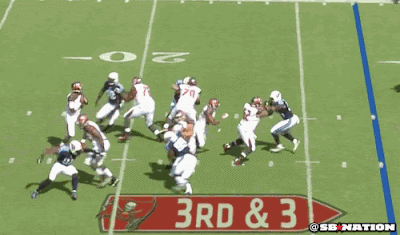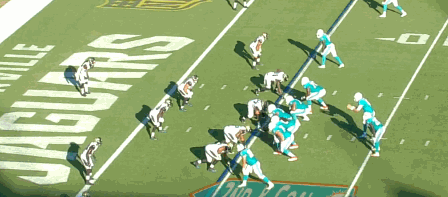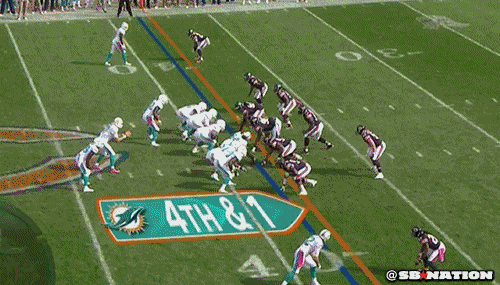The turn of the century has not been kind to the Oakland Raiders. After posting a 33-15 record with three AFC West titles and a Super Bowl appearance during the first three seasons of said century, they have yet to reach the playoffs or post a winning record. What's more, they've gone through nine different head coaches and a whopping 18 quarterbacks since 2000; this stretch of futility is the result of the late Al Davis' substandard first round draft choices of the likes of Robert Gallery, Fabian Washington, Darrius Heyward-Bey, Tyler Brayton and JaMarcus Russell. One poor draft can substantially set a franchise back, but multiple can cripple a franchise for years.
Enter quarterback Derek Carr, the third year passer from Fresno State who measures at 6'3," 218 pounds with impeccable arm talent. Prior to his stint as a Bulldog, Carr rewrote the Central Section record books at Bakersfield Christian at the helm of CIF Division V champions. Following the completion of his senior season in 2009, he was named the National Player of the Year by the National Private Schools Athletic Association.
From there, all Carr did was rewrite Fresno State's record book previously littered with marks held by his older brother, David; Derek would finish with 12,843 yards and 113 touchdowns through the air against a meager 24 interceptions. He garnered first round buzz as the 2013 season progressed, but "questions" regarding how the family's lineage would prove impactful for his future with the Houston Texans, who held the number one pick, surfaced just weeks prior to the draft (David was taken number one overall by the Texans in 2002, but failed to live up to the billing albeit being in a terrible situation). Following a disappointing performance against USC in the Las Vegas Bowl, more questions persisted regarding his ability to handle next-level competition.
The Raiders took a flier on him in the second round and never looked back: after briefly battling with Matt Schaub, head coach Dennis Allen named Carr the starting quarterback for the 2014 season. He flashed signs of brilliance as a rookie, throwing for 3,270 yards and 21 touchdowns while managing to take care of the ball (12 interceptions) behind an underwhelming offensive line with an equally underwhelming supporting cast. Perhaps the most eye-popping stat were his 599 attempts, the second most by a rookie in NFL history, coupled with the fact he was able to keep his rookie mistakes to the bare minimum. Regardless, it's extremely difficult to win games when you ask your rookie quarterback to throw the ball 37 times a game, and the Raiders 3-13 record was a direct reflection of such sentiment.
This past season proved to be far more exciting for Raider Nation with the additions of receivers Michael Crabtree and Amari Cooper and the growth of running back Latavius Murray, providing Carr with the necessary weapons. Cooper became the first Raiders receiver to exceed the century mark in an NFL-most 11 seasons, while Murray tallied that same number on the ground as the first Raider to do so since 2010. In turn, Carr's numbers rose to 3,987 yards and 32 touchdowns against 13 interceptions despite 26 fewer attempts. His 53 touchdowns through his first two seasons rank second in NFL history.

When you turn on Carr's film as a rookie, you wouldn't know he was one: his play showed very little indication of a rookie quarterback behind center while it was evident he elevated those around him. This video showcases the anticipation and aforementioned arm talent Carr possesses; he is rolling right when he recognizes his receiver getting to the top out of his route. Carr knows this receiver now has the leverage and throws it at the ideal time with some serious zip that creates tight spirals at all levels of the field.
/cdn0.vox-cdn.com/uploads/chorus_asset/file/676054/carr-3.0.gif)
This play is one of my favorites and comes from his 2014 preseason start against the defending champion Seahawks who Carr shredded (against their starters mind you) for 143 yards and three touchdowns and zero interceptions on 11-for-13 passing. This touchdown encompasses a multitude of areas where Carr excels. After setting up off of play action, Carr manipulates the single-high safety with his eyes, holding him there just long enough to eliminate him making a play on the ball; although Carr has struggled with bird dogging his the target the past two seasons, he's shown progress in that field. He recognizes he doesn't like the read post-snap so he steps up in the pocket, resets his feet and delivers a beautifully thrown ball by elevating his shoulder plane and and climbing his plant leg for optimum trajectory. Granted the receiver has a three yard cushion on the defensive back, but dropping the ball in the bucket as such is imperative when that cushion is reduced to inches.


The first video came from his career start against a talented Jets defense. For starters, Carr is a student of the game who can quickly recognize coverages and rotations, doing so here by seeing the Jets bring pressure off the edge with Cover 1 behind it. He sees this pre-snap and knows he's going to throw hot and take what the defense gives him, which in turn allows hims weapons to work with the ball. Carr puts the ball in a good spot and keeps his receiver on his route for an easy six. As for the second, you'll notice Carr's deep anticipation and ability to throw to a spot that Chargers' defensive back Jason Verrett has little chance of disrupting. The anticipation comes into play as the Chargers roll to a Cover 1 Robber look, forcing the free safety to play center fielder. Carr holds him there before releasing the ball just as his receiver gains leverage on Verrett; too early and the safety makes a play on the ball, but too late and you deviate from attacking the proper single-high window.
While Carr has grown over the last two seasons, there are still glaring deficiencies in his game. Through Week 13 of the 2015 season, seven of Carr's then-nine interceptions had come in the fourth quarter while six came when the Raiders were trailing by only a score. Those are attributed to the bird dogging I previously mentioned, but he is not immune to the forced throw or slow mental clock; he is a great athlete who can get outside the pocket and extend plays with his feet, but there have been multiple occurrences of him holding the ball longer than the route concepts suggest. In that same time period, Carr also posted a lowly fourth quarter passer rating of 55.6
He is a young passer who is still mastering his craft and will likely cut down on the mental mistakes in year three. The Raiders offense is fun to watch due to offensive Bill Musgrave's use of multiple formations and personnel groupings that feature Carr both under center and in the gun. His play calling was rather predictable in 2014 and defenses capitalized on that, but with Murray's growth on the ground and through the air, Musgrave presented the opposition with more challenges. Oakland overhauled their offensive front and quite possibly boast the second unit of any team not named the Dallas Cowboys. I also expect the Raiders to give tight end Clive Walford an increased workload after his improvements in 2015. All points back to Carr, who should take that imperative Year Three leap.







/cdn0.vox-cdn.com/uploads/chorus_asset/file/676054/carr-3.0.gif)





